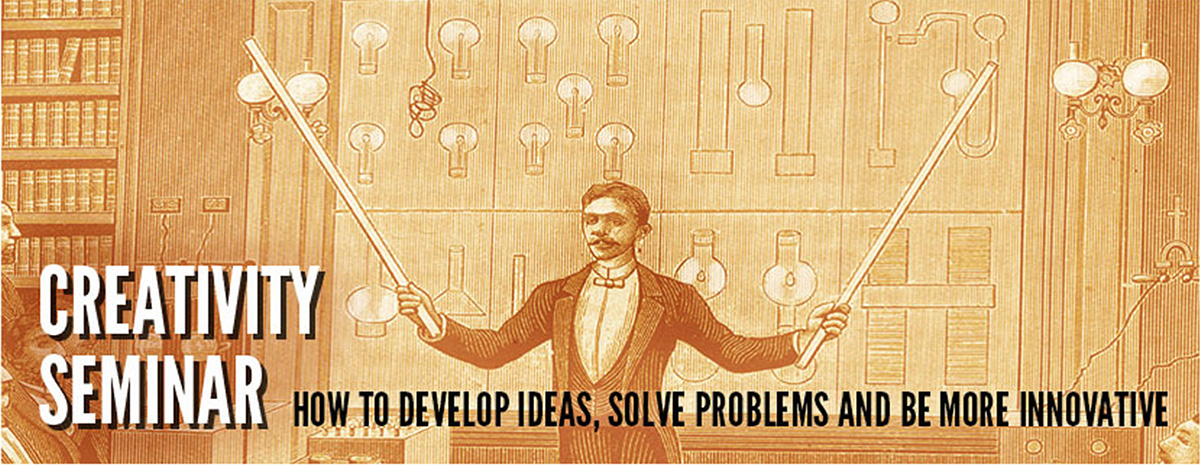Creativity doesn't need to be random, abstract or mysterious. Its an ability that can be developed, practiced and improved. Creativity is not so much a talent as it is a learnable, goal-oriented methodology for producing breakthrough solutions. And if you know the tricks, you can perform some magic.
While innovation is an overused word in the business world, what’s
underemphasized is the crucial stage that
precedes innovation: how to think creatively.
Very often, individuals or groups will commit too soon to a concept that came to them quickly or was based on an existing product — feeling that they're being "innovative" — without first having imagined other possibilities and explored the potential for something truly original. It's partly out of laziness. They avoid what they see as work, not realizing that the creative process is really
play. What these groups lack are the tools for analyzing challenges and generating new ideas, the collection of techniques known as creative-thinking skills.
Deconstructed by Harvard Business School’s
Teresa Amabile, creativity has three components: expertise, motivation, and creative-thinking skills. She first diagrammed this intersection in her 1998 HBR article, “
How To Kill Creativity.” By understanding these three components and how to use them effectively, Amabile explains, we can become more creative.
As Sean Kelly teaches in his
Creativity Seminar, the third and the most essential of these components, creative-thinking skills, can be learned, and applied, through deliberate practices, allowing the creative process to become a natural habit.
The Three Components of Creativity:
EXPERTISE is the in-depth knowledge — technical, procedural and intellectual — and the mastery and experience individuals have in their particular field.
MOTIVATION determines the degree to which an individual is willing to do something, and how likely they are to persevere through obstacles and setbacks. But motivation is a coin with two sides: extrinsic and intrinsic.
EXTRINSIC MOTIVATION is a force outside the individual — and the most common one is money, as in bonuses or promotions. But, extrinsic motivators may sabotage creative efforts because they often encourage doing the job just to get something desirable or avoid something painful. And, they leave employees looking merely for the simplest, straightest path, solving the problem exactly as it was solved before. Teresa Amabile years ago posed a question to participants in a study: If you were paid more, would you do better work? The surprising answer was “no.”
INTRINSIC MOTIVATION, from within the individual and the work itself, encourages people to work for the challenge, enjoyment, and satisfaction of doing a particular task or project. The advantage of intrinsic motivators is that the level of reward and gratification an employee experiences is directly tied to the success of the assignment. Amabile found that intrinsic motivations are more effective for creativity. An inner passion to solve a problem, and a love of the process, lead to far more creative solutions than do external rewards like money.
CREATIVE-THINKING SKILLS are the multiple tools that individuals apply to problems — in particular, their capacity to put existing ideas together in new combinations. These creative-thinking skills include techniques for accurately defining a problem, seeing challenges from new perspectives, generating multiple ideas, selecting the optimum alternatives, and implementing those solutions as products. Students and workers in many fields are well versed in
critical thinking, but most are much less familiar with its opposite skill; creative thinking.
Regardless of how much expertise and motivation we might have, if we don't know how to develop new ideas, we never will be innovative.
In more detail, the subsets of these creative-thinking skills can be examined on four deeper levels — cognitive; affective; personal and motivational; and social or environmental.
Among these, cognitive and affective elements are arguably the most important.
Cognitive aspects of creativity include expertise, as in knowledge both general and field-specific. But the cognitive also involves perceptiveness, originality, attraction to complexity (e.g., combining, analyzing, and applying different, disparate concepts), open-mindedness (e.g., resistance to closure, tolerance for ambiguity) and — very simply — awareness of creativity, in ourselves and others.
Affective elements include curiosity, humor, independence and risk-taking, all of which are crucial skills.
At the intersection of our expertise and our motivation, if we add the least emphasized but most valuable skill of all, creative-thinking, we’ll find our greatest creativity.
(Based on the research of Teresa Amabile, the Edsel Bryant Ford Professor of Business Administration at Harvard Business School and author of Growing Up Creative: Nurturing a Lifetime of Creativity, as well as Creativity in Context, and The Progress Principle: Using Small Wins to Ignite Joy, Engagement and Creativity at Work, with Steven Kramer.)




































